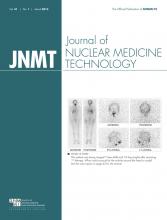Abstract
We present an interesting case of a post-90Y radioembolization PET scan acquired with the aide of respiratory gating. We postulated that respiratory gating would allow accurate tracking of the tumor position, which may be altered by patient breathing. Time-of-flight image reconstruction was used to produce images with less noise in fewer iterations than is possible with conventional PET.
The internal pair production property of 90Y makes possible its use for imaging by PET (1). Although imaging is impeded by the fact that 90Y is a pure β-emitter, chemically identical surrogates can be used instead (2). In this case, 86Y was the isotope of choice during the scan.
CASE REPORT
A 66-y-old man with hepatocellular carcinoma was radioembolized in the left and right hepatic lobes with 0.4 and 1.4 GBq of 90Y, respectively. Using a 40-slice mCT PET scanner (Biograph; Siemens Medical Solutions) and a respiratory gating hardware system (ANZAI Medical Co., Ltd.), we obtained the PET/CT scan approximately 14 h after 90Y implantation. The CT scan for attenuation correction was obtained at an energy of 120 kV. In total, 86 images (3.0-mm slices) were generated. The CT scan was followed by the PET scan, using 2 bed positions at 10 min each (total scan time, 20 min), aided by respiratory gating with the liver in the field of view. Images were then reconstructed using the TrueX algorithm plus time-of-flight reconstruction (UltraHD PET; Siemens Medical Solutions) with 2 iterations, 21 subsets, and a filter of 2 mm. Post-90Y radioembolization PET/CT showed the microsphere biodistribution in both hepatic lobes (Fig. 1).
Right hepatic lobe showing 90Y biodistribution. A color version of this figure is available as a supplemental file at http://tech.snmjournals.org.
DISCUSSION
In this interesting case, a post-90Y radioembolization PET scan was acquired with the aide of respiratory gating. We postulated that respiratory gating would allow accurate tracking of the tumor position despite the movement caused by patient breathing. In addition, time-of-flight image reconstruction was used to produce images with less noise and in fewer iterations than is possible with conventional PET. The biodistribution of microspheres in both hepatic lobes could be visualized.
CONCLUSION
Respiratory gating aided in the accurate tracking of tumor position, and time-of-flight reconstruction provided better images with less noise.
DISCLOSURE
No potential conflict of interest relevant to this article was reported.
Footnotes
Published online Jan. 31, 2013.
- Received for publication September 26, 2012.
- Accepted for publication January 14, 2013.








